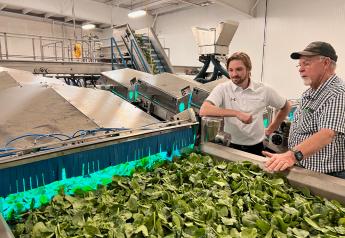USDA report: Higher input costs will slow South Africa citrus expansion

Rising farm input costs, higher shipping rates, new phytosanitary regulations imposed by the European Union and other factors will slow South African citrus export expansion in the coming season, a new USDA report says.
Other factors limiting South African citrus exports include inflationary pressures on consumers in key markets and infrastructure inefficiencies, according to the report.
“These factors are reducing the profitability of the sector, resulting in restrained investment in the industry,” the report said.
The area under citrus cultivation in South Africa has grown steadily over the past decade, pushed ahead by ongoing investments and relatively high earnings from export markets.
At about 2.7 million metric tons, South Africa set a record for citrus exports in 2021-22, according to the report. The expansion in citrus orchards is expected to ease in marketing year 2022-23, the report said.
Planted citrus orchards in South Africa account for more than 247,000 acres, of which orange orchards represent approximately 47%.
“The area planted to oranges grew by almost 14% over the past seven years or by an average 2% per annum,” the report said. However, growth in orange area was limited by an aggressive shift to soft citrus in the growing regions of the Western Cape and Limpopo provinces.
The USDA anticipates acreage growth will be only marginal in marketing year 2022-23, with planted orange area at nearly 119,000 acres, up about 1,000 acres from the previous season.
Orange production in South Africa will grow by 3% in marketing year 2022-23 to almost 1.7 million metric tons, the report said. The USDA forecasts that South Africa’s 2022-23 orange exports will reach 1.4 million metric tons, also up 3% from the previous year.
South Africa exports oranges to more than 100 countries around the world, with the European Union accounting for 40% of total orange exports.
“However, despite a free trade agreement with the EU that allows duty-free access for citrus exports, South Africa continues to face phytosanitary challenges in the EU market due to the prevalence of citrus black spot (CBS) and false codling moth (FCM),” the report said. The citrus industry estimates that it spends millions to comply with the CBS and FCM requirements in the EU market.
On July 14 this year, the EU required that imports of citrus fruit undergo specified cold treatment processes and pre-cooling steps for specific periods before importation to ensure protection against FCM. These changes were introduced in the middle of South Africa’s export season, which made implementation difficult and time sensitive.
An estimated 1,350 containers of citrus fruit were detained at EU ports for several weeks, which resulted in an estimated $12 million in losses on reduced quality and transaction costs, the report said. South Africa is seeking changes to the treatment regulations through the World Trade Organization, the report said.
South Africa’s export of oranges to the U.S. are expected to continue to grow, the report said, benefitting from duty-free access under African Growth Opportunity Act (AGOA). 2021-22 orange exports to the U.S. were 53,284 metric tons, the report said.
The report said the area planted in South Africa to tangerines/mandarins has grown “exponentially” over the past seven years, driven by higher global demand for seedless soft citrus and relatively higher profit margins compared to other citrus types.
However, the USDA said the aggressive growth in soft citrus area will slow down in marketing year 2022-23.
“The industry is concerned that demand for soft citrus is softening in key markets such as the EU and United Kingdom due to inflationary pressures on consumers and an expected weakening in economic growth,” the report said.
In marketing year 2021-22, the area planted with tangerines/mandarins grew by an estimated 7%, to nearly 70,000 acres.
The report said South African tangerine/mandarin production will grow by 6% percent in marketing year 2022-23 to 670,000 metric tons.
The USDA report said South African exports of tangerines/mandarins will grow by almost 8% in marketing year 2022-23 to reach a record level of 560,000 metric tons.
The EU and the United Kingdom together account for 45% of total South African exports of soft citrus, followed by Russia (10%), the U.S. (10%) and United Arab Emirates
South Africa’s exports of soft citrus to the U.S. under AGOA have grown exponentially over the past five years, from 11,180 metric tons in marketing year 2016-17 to 48,820 metric tons in marketing year 2021-22.
This growth trend is expected to continue based on the expanding preference for easy peelers in the U.S. market and continued duty-free market access under AGOA, the report said.
South Africa exports citrus to the U.S. under a cold treatment schedule to address FCM. The USDA has reduced the cold treatment schedule from 24 days to 22 days, which has been beneficial to South Africa in terms of reducing shipping costs and fruit loss from cold damage.
Currently, South Africa can only export citrus to the U.S. from officially recognized CBS-free areas. The CBS-free areas are found in the Western Cape and Northern Cape provinces, as well as relevant districts of the Free State and Northwest provinces.
In 2014, the USDA's Animal and Plant Health Inspection Service (APHIS) issued a notice proposing to amend fruit and vegetable regulations to allow the import of several varieties of fresh citrus fruit, as well as citrus hybrids, into the U.S. from areas in South Africa where citrus black spot has been known to occur. The regulation would authorize imports on the condition of satisfying certain systems and SPS treatment procedures. The comment period closed, and the regulation is still in the process of being finalized, according to the report.







